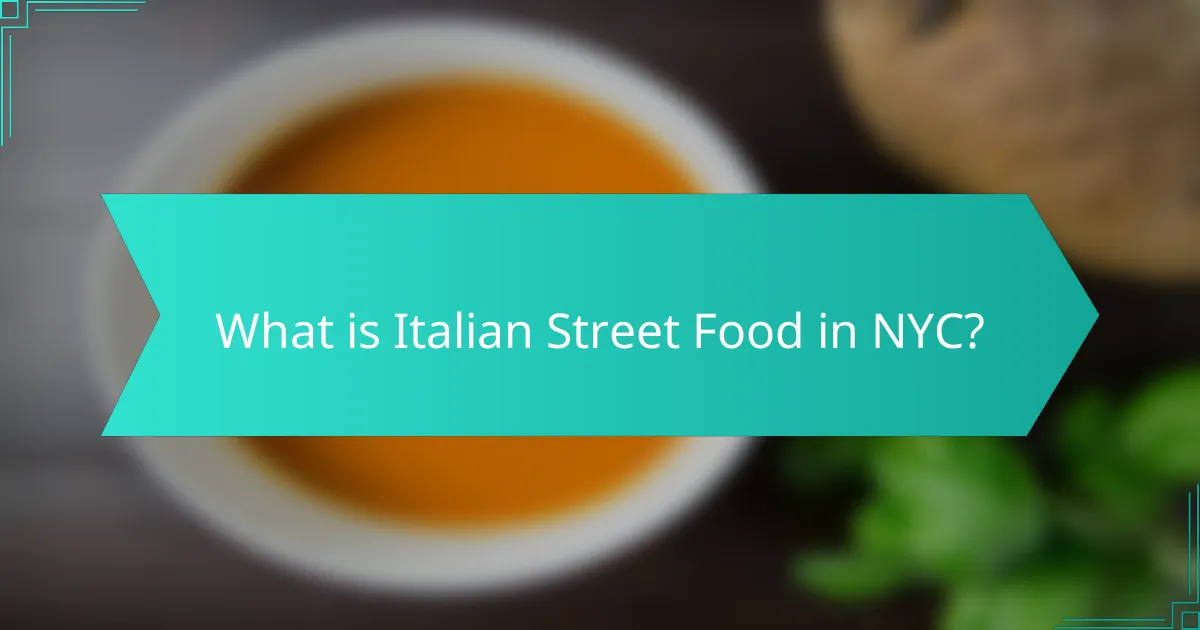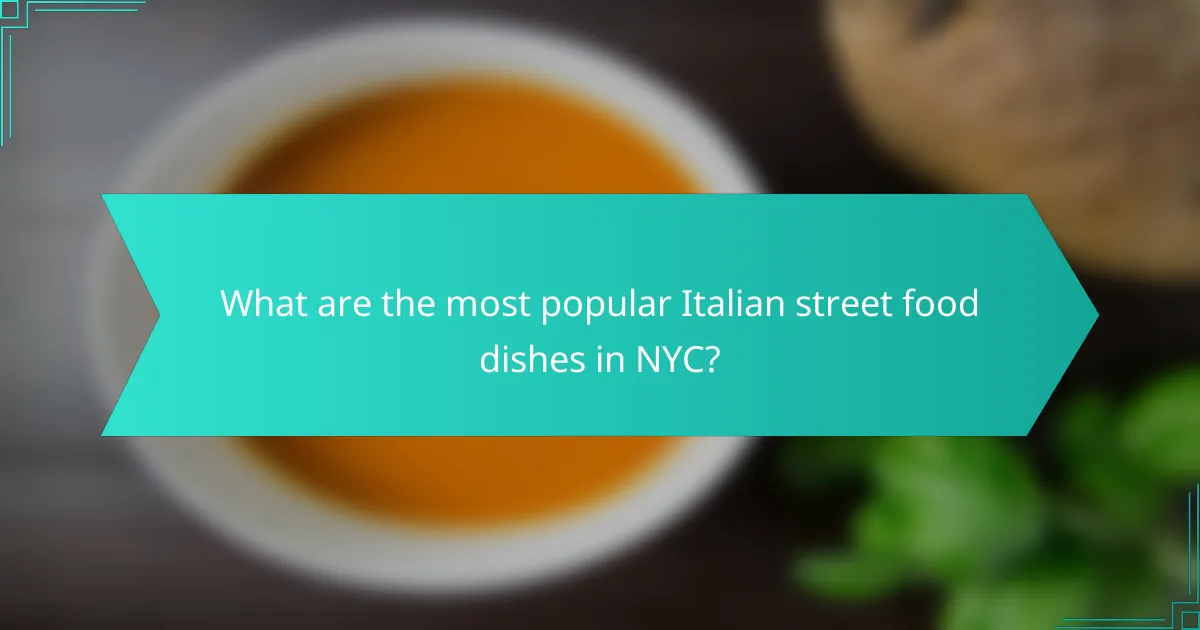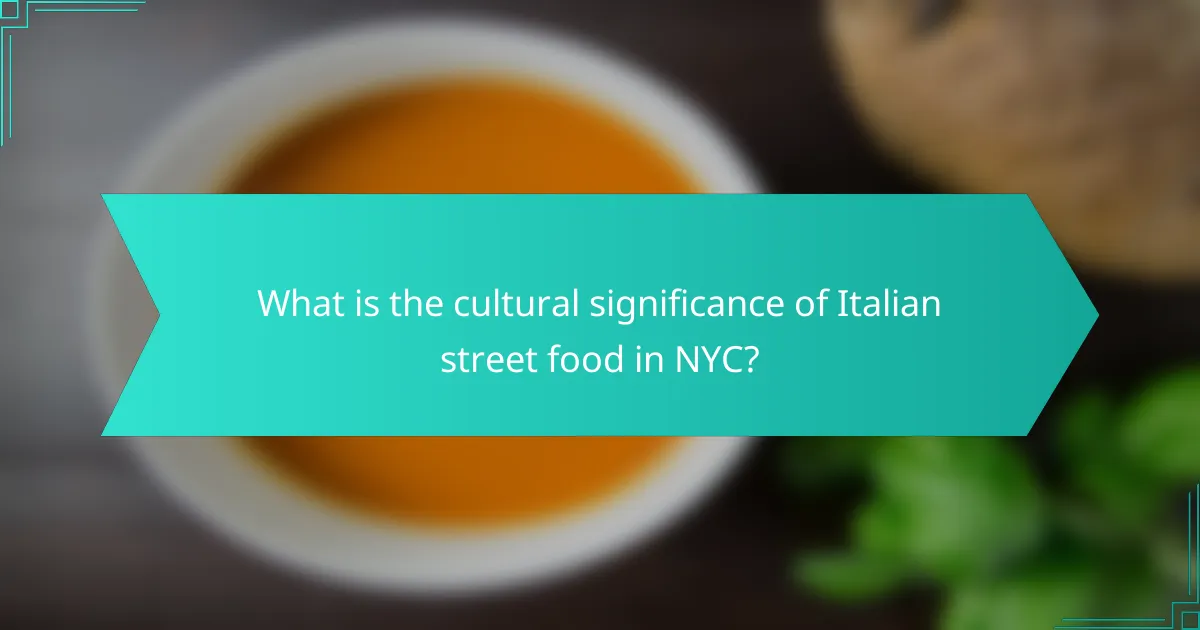Italian street food in New York City encompasses a variety of quick and flavorful dishes inspired by traditional Italian cuisine, primarily sold by vendors in neighborhoods with rich Italian heritage. Key dishes include arancini, fried rice balls filled with cheese or meat; pizza al taglio, rectangular pizza sold by weight; and panini, pressed sandwiches with various fillings. Notable vendors such as Di Fara Pizza, Arancini Bros, and Gelato Giotto contribute to the vibrant food scene, reflecting the cultural significance of Italian street food in the city. This culinary tradition not only highlights the immigrant experience but also fosters community identity among Italian Americans, reinforcing social bonds through food festivals and cultural events.

What is Italian Street Food in NYC?
Italian street food in NYC refers to a diverse range of quick, flavorful dishes inspired by Italian cuisine. This food is typically sold by vendors in various neighborhoods, particularly in areas with a high concentration of Italian heritage. Popular items include arancini, which are fried rice balls filled with cheese or meat. Another favorite is the panini, a pressed sandwich filled with meats, cheeses, and vegetables. Additionally, pizza by the slice is a staple, often featuring classic toppings like pepperoni and fresh basil. Vendors often operate from food trucks or stands, making these dishes accessible to locals and tourists alike. The cultural significance of Italian street food in NYC reflects the city’s rich immigrant history, showcasing culinary traditions that have evolved over generations.
How did Italian street food become popular in NYC?
Italian street food became popular in NYC through the influx of Italian immigrants in the late 19th and early 20th centuries. These immigrants brought their culinary traditions, including pizza, pasta, and various pastries. Food carts and street vendors emerged in neighborhoods like Little Italy, offering affordable and quick meals. The rise of food culture in NYC during the 1970s and 1980s further fueled interest in diverse cuisines. Events like street fairs and food festivals showcased Italian street food to a broader audience. Today, Italian street food is celebrated for its flavors and cultural significance in the city’s dining scene. The popularity continues as food trucks and modern eateries reinvent traditional dishes.
What historical events influenced the rise of Italian street food?
The rise of Italian street food was influenced by several historical events. The mass migration of Italians to the United States in the late 19th and early 20th centuries brought diverse culinary traditions. Economic hardships in Italy prompted many to seek better opportunities abroad. As they settled in urban centers, food became a means of cultural expression. Street vendors emerged to cater to the growing demand for affordable, quick meals. The introduction of Italian dishes like pizza and pasta in American cities popularized these foods. Additionally, the post-World War II era saw a resurgence of Italian cuisine as American culture embraced ethnic foods. These events collectively shaped the landscape of Italian street food in America.
How have immigrant communities shaped Italian street food culture?
Immigrant communities have significantly shaped Italian street food culture by introducing diverse flavors and cooking techniques. These communities, particularly from Southern Italy, brought traditional recipes and ingredients. For instance, Sicilian immigrants popularized arancini, or rice balls, in the early 20th century. They also introduced dishes like panelle, made from chickpea flour, which became staples in street food vendors’ offerings.
Additionally, the blending of various immigrant influences led to unique street food innovations. The fusion of Italian culinary practices with local ingredients created new dishes, enhancing the street food landscape. Vendors often adapt traditional recipes to cater to diverse palates.
The presence of these immigrant communities has contributed to the rich tapestry of flavors in Italian street food. Their cultural heritage is reflected in the variety of offerings available today. This evolution showcases the dynamic nature of food culture in urban environments like New York City.
What are the defining characteristics of Italian street food?
Italian street food is characterized by its simplicity, freshness, and regional diversity. It typically includes quick, portable dishes that are easy to consume on the go. Common ingredients feature high-quality local produce, meats, and cheeses. Popular items include pizza al taglio, arancini, and panini. Italian street food often reflects the culinary traditions of specific regions, showcasing local flavors and techniques. Vendors prioritize authenticity and often prepare food using traditional methods. The food is usually served in casual settings, promoting a communal dining experience. Festivals and markets frequently celebrate this vibrant food culture, emphasizing its significance in Italian society.
What ingredients are commonly used in Italian street food?
Common ingredients in Italian street food include flour, tomatoes, cheese, and various meats. Flour is used for making dough for pizzas and focaccias. Tomatoes are often a base for sauces in dishes like arancini and pasta. Cheese, particularly mozzarella, is a key component in many street foods. Meats such as prosciutto and salami are frequently included in sandwiches and wraps. Fresh herbs like basil and oregano enhance the flavors of many dishes. Olive oil is commonly used for cooking and drizzling. These ingredients reflect traditional Italian cuisine and its emphasis on fresh, high-quality components.
How does the preparation of Italian street food differ from traditional Italian cuisine?
Italian street food preparation differs from traditional Italian cuisine in its emphasis on speed and convenience. Street food is typically made for quick consumption, often prepared in small portions. Traditional Italian cuisine focuses on elaborate techniques and lengthy cooking processes. Street food vendors prioritize simple recipes that require minimal cooking time. Common street food items include pizza slices and arancini, which are easy to eat on the go. In contrast, traditional dishes like lasagna or risotto require more time and skill to prepare. The accessibility of street food encourages a casual dining experience, while traditional cuisine is often enjoyed in a sit-down setting.

What are the most popular Italian street food dishes in NYC?
The most popular Italian street food dishes in NYC include arancini, pizza al taglio, and panini. Arancini are fried rice balls filled with cheese or meat. They are a beloved snack found at many food vendors. Pizza al taglio is rectangular pizza sold by weight. This style offers various toppings and is often enjoyed as a quick meal. Panini are pressed sandwiches filled with meats, cheeses, and vegetables. They are widely available and customizable. These dishes reflect the rich Italian culinary tradition in New York City. Their popularity is evident in food festivals and local eateries.
Which dishes are considered staples of Italian street food?
Staples of Italian street food include pizza al taglio, arancini, and supplì. Pizza al taglio is a rectangular pizza sold by the slice. It features various toppings and is often enjoyed warm. Arancini are stuffed rice balls, typically filled with meat or cheese. They are coated in breadcrumbs and deep-fried until golden. Supplì are similar to arancini but are usually filled with mozzarella. These dishes are popular in street markets and food stalls throughout Italy. Their origins trace back to traditional Italian cuisine, reflecting regional flavors and ingredients.
What is the significance of pizza al taglio in NYC’s Italian street food scene?
Pizza al taglio is significant in NYC’s Italian street food scene as it represents authentic Roman-style pizza. This pizza is characterized by its rectangular shape and thick, airy crust. It is sold by weight, allowing customers to choose their desired portion. This format caters to the fast-paced lifestyle of New Yorkers. The variety of toppings showcases traditional Italian flavors, enhancing its appeal. Additionally, pizza al taglio fosters a communal dining experience common in Italian culture. Its rise in popularity reflects the broader trend of gourmet street food in NYC. This dish has become a staple, found in numerous food trucks and eateries across the city.
How do arancini reflect the diversity of Italian street food offerings?
Arancini exemplify the diversity of Italian street food by showcasing regional flavors and ingredients. These rice balls originate from Sicily and are typically filled with various ingredients like cheese, meat, or vegetables. Their preparation methods vary, with some being fried and others baked, reflecting local culinary traditions. The fillings can include ragù, peas, or saffron, highlighting the use of local produce and flavors. Arancini are often served at festivals and street fairs, making them a popular choice among vendors. This versatility allows arancini to cater to different tastes and dietary preferences. Their presence in Italian street food culture illustrates the blend of tradition and innovation in Italian cuisine.
What unique Italian street food dishes can be found in NYC?
Unique Italian street food dishes found in NYC include arancini, supplì, and panzerotti. Arancini are deep-fried rice balls typically filled with cheese or meat. Supplì are Roman-style rice croquettes, often featuring a gooey mozzarella center. Panzerotti are stuffed pastries, usually filled with tomato and mozzarella. These dishes reflect regional Italian cuisine. Vendors across NYC serve these delicacies, showcasing Italian culinary traditions. Popular areas for these foods include Little Italy and food markets. The presence of these dishes highlights the cultural significance of Italian heritage in the city.
How does the variation of cannoli in NYC differ from traditional recipes?
The variation of cannoli in NYC often features unique fillings and toppings not found in traditional recipes. Traditional cannoli typically consist of a ricotta cheese filling with minimal adornments. In NYC, vendors often incorporate flavors like chocolate, pistachio, and even fruit into the filling. Additionally, some variations include toppings such as crushed nuts, sprinkles, or chocolate chips on the ends. The shells may also be fried to different degrees of crispiness, offering a diverse texture experience. This adaptation reflects the city’s multicultural influences and the creativity of local pastry chefs. Such variations cater to diverse palates and preferences, making cannoli a popular street food choice in NYC.
What role do seasonal ingredients play in the creation of Italian street food dishes?
Seasonal ingredients are crucial in the creation of Italian street food dishes. They enhance freshness and flavor, providing authenticity to the cuisine. Using seasonal produce allows vendors to offer dishes that reflect local agricultural cycles. This practice supports sustainability by reducing transportation emissions. For example, summer brings tomatoes and basil, essential for classic Caprese salads. In fall, mushrooms and chestnuts become popular in various recipes. The reliance on seasonal ingredients fosters a connection between food and culture. It also encourages creativity among chefs as they adapt recipes based on availability. Overall, seasonal ingredients play a vital role in maintaining the integrity and appeal of Italian street food.

Who are the key vendors of Italian street food in NYC?
The key vendors of Italian street food in NYC include Di Fara Pizza, known for its classic New York-style pizza. Another prominent vendor is Arancini Bros, specializing in Sicilian arancini. Additionally, Gelato Giotto offers authentic Italian gelato. These vendors are popular for their quality and traditional recipes. They contribute significantly to the vibrant Italian street food scene in New York City.
What are some of the most popular Italian street food vendors in NYC?
Some of the most popular Italian street food vendors in NYC include Arancini Bros, La Bella Torte, and The Meatball Shop. Arancini Bros specializes in stuffed rice balls, offering various fillings. La Bella Torte is known for its authentic Italian pastries and desserts. The Meatball Shop serves a variety of meatball dishes, including subs and sliders. These vendors attract both locals and tourists. Their offerings reflect traditional Italian street food culture. Each vendor has garnered positive reviews and a loyal customer base. Their popularity is evident through long lines and social media presence.
What distinguishes these vendors from others in the city?
These vendors are distinguished by their authentic recipes and high-quality ingredients. They often use traditional methods passed down through generations. This commitment to authenticity sets them apart from other street food vendors. Many of these vendors source ingredients locally, ensuring freshness and supporting local farmers. Their unique offerings include regional specialties not commonly found elsewhere in the city. Additionally, they create a strong connection with the community through cultural events and food festivals. This engagement enhances their reputation and customer loyalty. Overall, their focus on quality and community involvement makes them stand out in NYC’s vibrant food scene.
How do vendor locations affect their popularity and success?
Vendor locations significantly influence their popularity and success. High foot traffic areas attract more customers. Locations near tourist attractions or busy streets see increased visibility. Proximity to public transportation enhances accessibility for potential patrons. Vendors in vibrant neighborhoods benefit from the local culture and community support. Seasonal events and festivals can boost vendor popularity when located strategically. Research shows that vendors in prime locations can experience sales increases of up to 50%. Overall, the right location is crucial for maximizing customer reach and sales potential.
What challenges do Italian street food vendors face in NYC?
Italian street food vendors in NYC face several challenges. Regulatory hurdles are significant, including obtaining permits and licenses. Compliance with health and safety regulations can be complex. Competition from other food vendors is intense in popular areas. Economic pressures impact pricing and profitability. Seasonal weather can affect customer turnout and sales. Additionally, maintaining product quality in a fast-paced environment is crucial. These factors collectively hinder the success of Italian street food vendors in New York City.
How do regulations impact the operation of street food vendors?
Regulations significantly impact the operation of street food vendors. They dictate where vendors can operate, affecting their visibility and customer access. Health and safety regulations ensure food quality and hygiene standards are met. Vendors must obtain permits, which can limit the number of operating licenses available. Compliance with zoning laws influences the locations where vendors can set up. Regulations also govern hours of operation, potentially restricting vendor income. Additionally, enforcement of these regulations can lead to fines or shutdowns for non-compliance. For instance, New York City has specific regulations that require street vendors to have a valid permit and adhere to health codes.
What strategies do vendors use to overcome competition in the market?
Vendors use various strategies to overcome competition in the market. They often focus on unique product offerings that differentiate them from competitors. This can include exclusive recipes or specialty ingredients that enhance flavor. Many vendors also emphasize quality and freshness to attract customers.
Additionally, effective branding and marketing play a crucial role. Vendors create strong brand identities to build customer loyalty. Engaging with customers through social media helps increase visibility and attract new patrons.
Competitive pricing strategies are also common. Vendors may offer promotions or discounts to entice customers. Location is another critical factor; vendors often choose high-traffic areas to maximize exposure.
Finally, excellent customer service can set vendors apart. Positive interactions encourage repeat business and referrals. These strategies collectively help vendors navigate a competitive landscape effectively.

What is the cultural significance of Italian street food in NYC?
Italian street food in NYC represents a fusion of cultural heritage and urban life. It reflects the immigrant experience and the adaptation of traditional recipes. Vendors often serve iconic dishes like pizza and cannoli, which have become staples in the city’s culinary landscape. The presence of Italian street food enhances community identity among Italian Americans. Events celebrating Italian culture often feature street food, reinforcing social bonds. Research indicates that food plays a vital role in cultural preservation and community cohesion. The popularity of Italian street food in NYC showcases its enduring legacy and influence on American cuisine.
How does Italian street food reflect the cultural identity of Italian-Americans?
Italian street food embodies the cultural identity of Italian-Americans through its flavors, traditions, and communal aspects. It showcases a blend of authentic Italian recipes and local adaptations. Dishes like pizza, arancini, and cannoli highlight regional Italian influences. These foods evoke nostalgia and a connection to heritage for many Italian-Americans. Vendors often operate in neighborhoods with strong Italian roots, fostering community ties. Festivals celebrating Italian cuisine further reinforce cultural pride. The popularity of Italian street food reflects the ongoing evolution of Italian-American identity. It serves as a culinary bridge between generations, preserving traditions while embracing modern influences.
What role does Italian street food play in community gatherings and festivals?
Italian street food serves as a central element in community gatherings and festivals. It fosters social interaction among attendees. Vendors offer a variety of traditional dishes, such as arancini and cannoli. These foods evoke cultural heritage and nostalgia for many participants. Festivals often feature food stalls that create a vibrant atmosphere. This encourages communal dining experiences, strengthening community bonds. The shared enjoyment of street food enhances the overall festive spirit. Events like the Feast of San Gennaro in NYC highlight this cultural significance through food.
How has Italian street food influenced other food cultures in NYC?
Italian street food has significantly influenced other food cultures in NYC. The introduction of dishes like pizza and arancini has inspired fusion creations. Food vendors often incorporate Italian techniques into diverse cuisines. For example, taco trucks may offer Italian-inspired fillings. Similarly, Asian food stalls have begun to experiment with Italian flavors. The popularity of Italian street food has led to a wider acceptance of global cuisines. This cross-cultural exchange enriches NYC’s culinary landscape. The city’s food scene now reflects a blend of traditions, thanks to Italian street food’s impact.
Why is Italian street food an important part of NYC’s culinary landscape?
Italian street food is an important part of NYC’s culinary landscape because it reflects the city’s diverse cultural heritage. This cuisine contributes to the vibrant food scene, attracting locals and tourists alike. Iconic dishes such as pizza, arancini, and cannoli are widely available from street vendors. These foods provide a quick, affordable dining option that resonates with the fast-paced lifestyle of New Yorkers. The presence of Italian street food also symbolizes the historical immigration patterns that shaped the city. Italian immigrants brought their culinary traditions, which have evolved into beloved street food offerings. This cultural exchange enriches NYC’s gastronomic identity and fosters community connections. Overall, Italian street food plays a crucial role in the city’s unique culinary narrative.
How does Italian street food contribute to the city’s economy?
Italian street food significantly contributes to the city’s economy by generating revenue and creating jobs. Vendors often operate small businesses that attract both locals and tourists. This influx of customers stimulates spending in surrounding areas.
Moreover, Italian street food supports local suppliers and farmers, promoting a sustainable food ecosystem. Events and festivals featuring street food enhance tourism, further boosting economic activity. According to a study by the NYC Department of Small Business Services, food vendors contribute over $300 million annually to the local economy.
Overall, Italian street food plays a vital role in enhancing the city’s economic landscape.
What impact does Italian street food have on tourism in NYC?
Italian street food significantly boosts tourism in NYC. It attracts food enthusiasts from around the globe. Iconic dishes like pizza and gelato are popular among visitors. Tourists often seek authentic culinary experiences. Food festivals featuring Italian street food enhance cultural engagement. Vendors contribute to the vibrant street life of the city. According to a study by the NYC Department of Tourism, food experiences account for a large portion of tourist spending. This trend highlights the importance of Italian street food in NYC’s tourism economy.
What tips can enhance the experience of enjoying Italian street food in NYC?
To enhance the experience of enjoying Italian street food in NYC, try visiting popular food trucks and stalls known for authentic dishes. Check local food blogs or apps for recommendations on the best vendors. Sampling a variety of dishes, such as arancini and cannoli, can provide a broader taste experience. Pair your food with a classic Italian beverage like limoncello or espresso for a complete meal. Visiting during food festivals can also offer unique, limited-time dishes. Engaging with vendors can provide insights into the food’s history and preparation methods. Lastly, enjoying your food in a vibrant public space can enhance the overall atmosphere.
Italian street food in NYC encompasses a variety of quick, flavorful dishes rooted in Italian culinary traditions, primarily sold by vendors in neighborhoods with a strong Italian heritage. Key dishes include arancini, pizza al taglio, and panini, which reflect regional diversity and cultural significance. The popularity of these foods has evolved from the influence of Italian immigrants, contributing to NYC’s vibrant food culture and community identity. Additionally, the article explores the challenges vendors face, the role of seasonal ingredients, and the impact of Italian street food on tourism and the local economy.